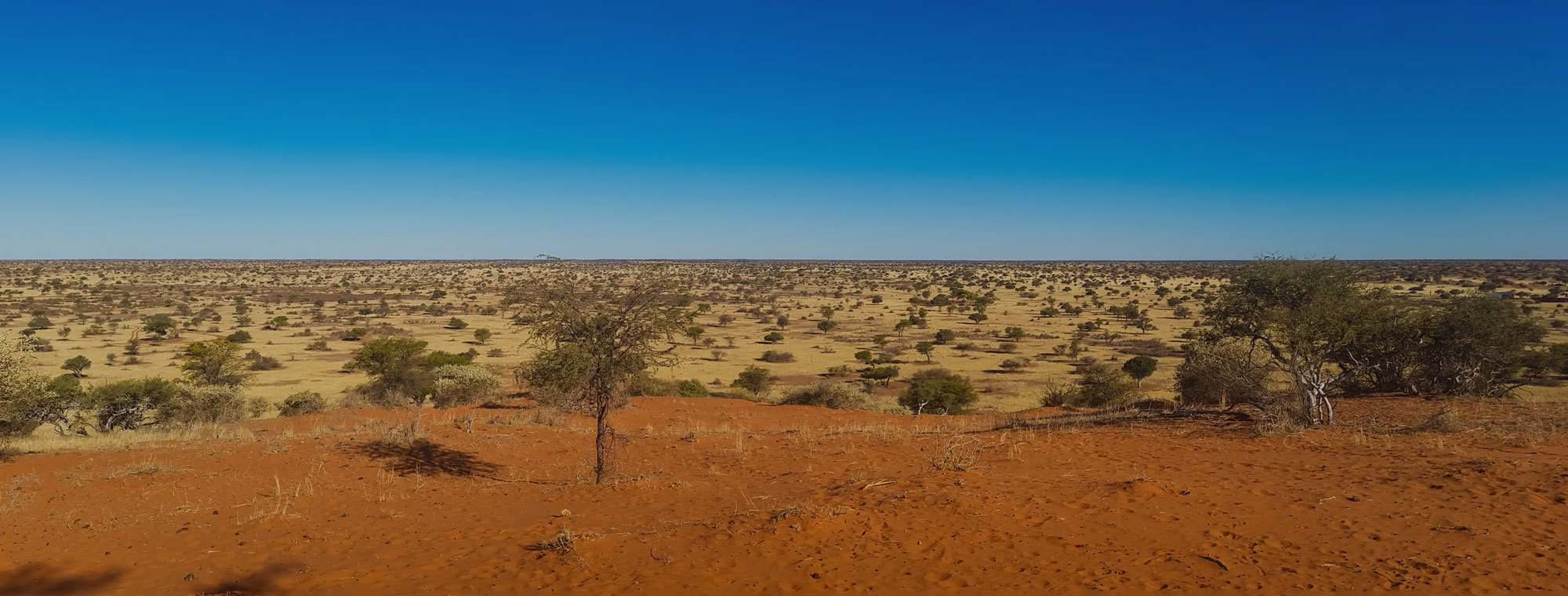Namibia Tours & Packages

If you're looking for a wild adventure full of cheetah, rhinos, and some of the largest sand dunes on earth, then Namibia is the destination for you. Go on the trip of a lifetime on one of our 11-13 Namibia safari tours.
Namibia Tours by Region
Namibia, a land of vast deserts, rugged mountains, and diverse wildlife, is a haven for adventurers and nature lovers. From the towering sand dunes of Sossusvlei to the wildlife-rich Etosha National Park, Namibia offers an unparalleled blend of natural wonders and unique cultural experiences. Discover its breathtaking landscapes and welcoming hospitality.
Sossusvlei & Namib Desert
The Namib Desert, one of the world’s oldest deserts, is home to Sossusvlei’s iconic red sand dunes. Climb Dune 45 for panoramic views and explore Deadvlei’s eerie, white clay pan with ancient camelthorn trees. The region’s stark beauty is a photographer’s dream.
Etosha National Park
Etosha is one of Africa’s premier wildlife destinations. Spot elephants, lions, rhinos, and a variety of bird species around the park’s salt pan and waterholes. Guided game drives offer unforgettable close encounters with Namibia’s rich fauna.
Swakopmund & Walvis Bay
Swakopmund, a charming coastal town, blends German colonial architecture with adventure activities. Nearby, Walvis Bay offers marine wildlife experiences, including boat tours to see dolphins, seals, and flamingos.
Damaraland
Damaraland’s rugged landscapes are dotted with fascinating geological formations and ancient rock art. Visit Twyfelfontein, a UNESCO World Heritage Site, and marvel at the Petrified Forest and Organ Pipes. The region is also home to desert-adapted elephants and black rhinos.
Frequently Asked Questions About Namibia Tours
When is the best time to tour Namibia?
The best time to visit Namibia is during the dry season from May to October, which is ideal for wildlife viewing and exploring the desert landscapes.
What are the best places to visit in Namibia?
Top destinations in Namibia include Etosha National Park, Sossusvlei, Swakopmund, and Fish River Canyon, and the Skeleton Coast.
What are the must-see attractions or things to do in Namibia?
Highlights in Namibia include exploring the towering sand dunes of Sossusvlei, experiencing the wildlife in Etosha National Park, and visiting the Skeleton Coast.
How many days should I spend in Namibia?
We recommend spending 10-14 days in Namibia to explore its natural wonders and cultural landmarks.
Do I need a visa to visit Namibia?
No. If you are a citizen of the USA, you do not need a visa for stays up to 90 days. U.S. travelers can check the latest visa and entry regulations with our easy-to-use Visa and Passport Requirements Tool.
Do I need any vaccinations to travel to Namibia?
Yes, vaccinations for hepatitis A, typhoid, and routine vaccinations are recommended for travel to Namibia. Always consult your doctor or a travel health clinic well ahead of your trip for the latest recommendations.
What is the currency in Namibia?
The currency in Namibia is the Namibian Dollar (NAD), and the South African Rand (ZAR) is widely accepted. While credit cards are also accepted in major cities and tourist areas, carrying local cash is recommended for smaller towns and markets.
What voltage do they use in Namibia?
The voltage is generally 230V with a frequency of 50Hz. Most modern electronics, such as phone chargers and laptops, are dual-voltage and only require a plug adapter. However, for devices that are not compatible with 230V, a voltage converter may be necessary.
Is English widely spoken in Namibia?
Yes, English is an official language and is widely spoken throughout Namibia.
Should I exchange money before I go to Namibia?
Most urban destinations accept major credit cards, but having some local currency can be helpful for small purchases. Learn more about exchanging money in our Guide to Currency Exchange and Payments While Traveling.
Is travel insurance necessary for a trip to Namibia?
Travel insurance provides peace of mind for unexpected situations like trip cancellations or medical emergencies. Learn why it’s recommended in our Travel Insurance Guide.
Can I take pictures of wildlife in Namibia?
Yes, you can generally take photographs of wildlife in Africa, including in national parks and reserves. Read our guide on Tips for Taking Photos on an African Safari and make sure to follow three important guidelines:
-
- Respect Park Rules: Be sure to stay on designated roads and viewing areas and follow any instructions from park rangers or guides. Some parks may require a permit for professional photography or drone use, so check the rules in advance if you’re bringing specialized equipment.
- Turn Off Location Tagging: To protect wildlife from poaching, disable any GPS or location tagging features on your camera and social media posts to avoid revealing the animals’ exact locations. Read our guide on How to Turn Off Location Tagging on Cameras and Smartphones to Protect Wildlife.
- Cultural Sensitivity & People: When traveling through local communities and groups, always ask for permission before taking a person's picture.
What is the weather like in Namibia?
Namibia has a desert climate with hot days and cool nights. The dry season is cooler, while the summer months can be very hot.
What are the must-try traditional dishes in Namibia?
Namibian cuisine includes dishes like biltong (dried meat), potjiekos (stew), kapana (street food), and fresh seafood in coastal areas. Don’t miss trying Namibian beer.
What should I pack for my trip to Namibia?
Packing for a safari tour in Africa requires careful consideration to ensure you have everything you need for a comfortable and enjoyable experience in the wild. It's best to travel light and prioritize the essentials. The less you bring, the easier it will be to move around and enjoy the experience without unnecessary weight. The specific items you'll need can vary based on the destination and time of year. Here's a general packing list to get you started:
-
- Passport and travel documents
- Neutral-colored clothing: Pack lightweight, breathable, and neutral-colored clothing (e.g., khaki, beige, green) to blend in with the natural environment and avoid attracting insects. Don't forget long-sleeved shirts and pants. Even though it's hot, long sleeves and pants will better protect you from the sun, insects, and any thorny vegetation you might encounter during walking safaris.
- Sturdy, comfortable shoes: Bring closed-toe walking shoes or hiking boots for bushwalks or trekking.
- Sun protection: Sunscreen with high SPF, wide-brimmed hat and sunglasses, UV-protective clothing. Africa has several coral reef systems along its coasts, particularly in the warm waters of the Indian Ocean. It's a good idea to bring reef-safe sunscreen formulated without harmful chemicals known to be damaging to coral reefs and marine life if you plan on swimming. Traditional sunscreens often contain ingredients like oxybenzone and octinoxate, which have been found to contribute to coral bleaching and negatively impact marine ecosystems. Look for sunscreens with certifications such as "Reef Safe," "Coral Safe," or "Ocean-Friendly" to ensure they are environmentally friendly.
- Medications and basic first aid: Any prescription medications you need. Basic first aid kit with adhesive bandages, antiseptic wipes, pain relievers, etc.
- Water bottle: You're going to want to bring your trusty water bottle to have with you at all times.
- Camera & binoculars: You’re traveling on a safari to see extraordinary scenery, animals, and sites. So that you don't miss a single moment, bring a trustworthy camera and a good pair of binoculars. Taking pictures of wildlife can be a daunting experience; everything is moving so fast, and the last thing you want is blurry photos to document one of the most extraordinary trips of your life. Also pack extra camera batteries and memory cards; you won't want to miss any photo opportunities.
- Small travel hair dryer (make sure you have the correct converter and adapter).
- A travel-friendly daypack or bag to carry your essentials during excursions.
What should I wear when visiting religious or cultural sites in Namibia?
When visiting religious or cultural sites in Namibia, it is best to dress modestly to show respect. Women should choose tops that cover the shoulders and skirts or pants that extend below the knee, while men are advised to wear long pants and shirts with sleeves. Carrying a light scarf or shawl can be useful, especially if you need extra coverage when entering sacred spaces. Dressing conservatively will help you honor local customs and ensure a positive cultural experience. For our detailed guide, check What to Wear When Visiting Religious Sites.
How much should I tip in Namibia?
Tipping in Namibia is generally appreciated, though not strictly required. In restaurants where a service charge is not included, leaving around 10% of your bill is customary. If you feel that a local guide or specialist has provided exceptional service, a tip of around 50 to 100 Namibian dollars per day is a thoughtful gesture. Ultimately, tipping should reflect your satisfaction with the service you receive. To avoid confusion, check our comprehensive Tipping Guide for International Travel.
What are some important cultural customs to know when traveling in Namibia?
Namibia is known for its warm hospitality and diverse cultural heritage, which is influenced by various indigenous communities as well as its colonial past. When interacting with locals, it is important to be polite and respectful, greeting people with a friendly smile or a simple "hello." Always ask for permission before taking photographs of individuals or community events, as this is considered courteous. In rural areas and traditional communities, modest clothing is appreciated, and a calm, considerate demeanor is valued in conversations. By showing sensitivity to local customs and traditions, you can build positive relationships and enrich your travel experience in Namibia. Read our Guide to Cultural Customs and Etiquette Abroad.
How do I stay connected while traveling in Namibia?
Many destinations offer Wi-Fi, but you may need a local SIM card or an international phone plan. Travelers exploring Namibia's remote wilderness may struggle to stay connected due to limited cell service and Wi-Fi, but that's part of the adventure—immersing in nature without digital distractions. For more details, visit our guide on How to Stay Connected While Traveling.
Are there any safety tips I should follow when traveling in Namibia?
Staying aware of your surroundings and keeping valuables secure is always wise. Read our Essential Safety Tips for Travelers.
How many months in advance should I plan a trip to Namibia?
We recommend you plan your trip to Namibia between 4 -10 months before you want to travel. Airlines don’t publish fares much further out than 10-11 months. Luckily, we take care of all of that for you! If travelers want to go for a special anniversary or event, they’ll call us years ahead of time to book so they know they are set and we're handling the details for them. While we love a great last-minute getaway, always ensure your passport is valid for at least six months after you plan to return to the States. Keep current with country entry restrictions, and ensure you have any visas you’ll need to travel. Planning earlier allows you plenty of time to renew your passport or apply for a visa if required.
Why You Should Travel to Namibia
Namibia is a destination of extraordinary contrasts, from its sweeping deserts to its lush wetlands. Whether you’re seeking adventure, wildlife encounters, or cultural exploration, Namibia offers a travel experience like no other. Its unspoiled beauty and welcoming people make it a must-visit destination for anyone with a love of nature and discovery. You can also check out our Frequently Asked Questions about Guided Vacations to learn more.




